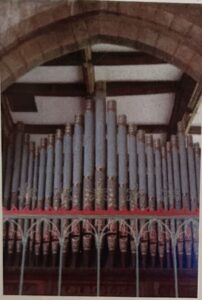
St. Mary’s Church is an historic Grade 1 listed building set in a three-acre churchyard within the Pinchbeck Conservation area. Its origins are Saxon and Norman, but the present building dates from the 12th Century. Throughout the medieval period the village traded horses, cattle, flax and hemp – the proportions of the church building reflect this prosperity. The Chancel was rebuilt by William Butterfield in 1861.
For further information click HERE

- The Font.
Near the base of the Tower, the Font is a richly studded, ornamental specimen of Perpendicular design. Its tall crocheted cover surmounted by a large cross can be seen in the area at the base of the tower. It was one of a matched pair, St. Laurence Church at Surfleet as the other.

- The Paschal or Easter candle.
This stands near the Font on a tall stand. It is lit every year at Easter to celebrate the resurrection of Jesus. It is also lit at Baptisms, as a reminder of the light of Jesus Christ. If the candle is not here, try to find it somewhere else in the church.

- The Tower.
If you look up, you will see the Arch that separates the roof of the Nave from the ceiling of the tower. This is a particularly high Arch and it makes Pinchbeck Church quite special. The colourful ceiling above you is the floor of the ringing chamber, where the bellringers stand to ring the bells. [The bells are housed in another room higher up above the ringing chamber]. There are eight bells, but only one can be rung from the ground floor where you are now [notice the rope]. Notice that the tower is on a lean. The tower started to lean when it was being built.
Map of St. Mary’s Church.
Photographs by M.c. PIOTOGRAPHY
- The Nave.
The main part of the Church [where people sit] is called the Nave. The eye shaped window in the white coloured wall is linked to a tiny belfry on the roof outside. In the belfry was a small bell that was rung during services. Painted and gilded wooden Angels, attached to the brackets of the hammer beam roof date from 1495, and carry shields bearing the arms of several families into which the Pinchbecks married.

- The Pulpit.
The pulpit has some lovely oak panels carved in 1915 by Belgian refugees funded by the Vicar, Rev’d Frank Field Wayet, whose son had been killed at the Battle of Loos in September 1915.

6. The Chancel and Nave Altar
- The Organ. The Organ by Forster and Andrews of Hull, dates from 1891.
It was the subject of a major restoration in 2006 as a result of a vestry fire.

- The Pinchbeck Tomb.
A large Tomb dating from medieval times is located near the Chancel. The Tomb is that of Sir Thomas Pinchbeck, a knight. It dates from the 15th Century. Originally the outside of the Tomb would have had brass shields attached to it and would have been painted in bright colours.

- The Lady Chapel.
The Chapel is used for quiet reflection and prayer for services of Holy Communion when fewer people are present. The Chapel is dedicated to St. Mary [the mother of Jesus, also known as Our Lady”].
Notice that the Altar here is carved with symbols relating to St. Mary: the LILY [purity], M for her name, the pierced heart reminding us of her suffering.
- The High Altar.
The High Altar is a focal point of the church. It is used in the same way as the Nave Altar, but usually only on special occasions such as Easter and Christmas. It is decorated with special cloth called a Frontal. Its colour varies according to the season. The area inside the railings is known as the Sanctuary. Nearby is an ancient stone sink piscina) for washing the communion vessels. Here also are carved figures that are symbolic of the four Gospel writers: Matthew [an angel], Mark [ a lion], Luke [an ox] and John (an Eagle]. A light shines above the Aumbry, where a small amount of bread and wine is put away after the Communion service. This is then taken to people who are too sick or disabled to come to church. They can have a service of Holy Communion at home.
- Doorways.
The door is locked but a stairwell leads up to the North West Tower and on to the roof.
11 and 13. Stained Glass Windows.
Each of the stained-glass windows has a laminated notice giving details of the story told in the window. The stories depicted in the windows are mainly bible stories. The windows were an important way of teaching bible stories in the days when many people couldn’t and didn’t own a copy of the bible. Although the biggest and most colourful windows are at the East and West ends of the church, the oldest stained-glass windows are at 11 near the vestry, and at 13.


